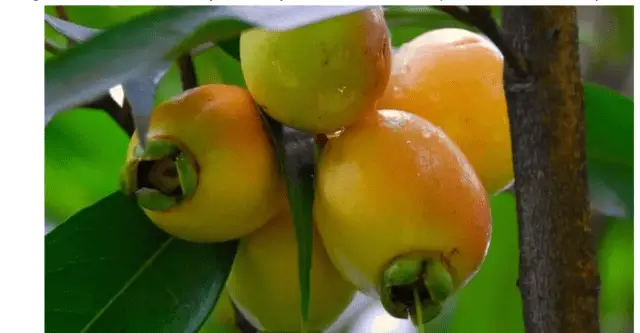The Syzygiumjambos, with the common name “rose apple” or perita, is a tree native to Southeast Asia belonging to the Myrtaceae family. In the country it is very common to find it in different areas of the national territory. In the case of the North Zone, you can often see paddocks or fences.
The tree reaches a size of 10 to 25 meters high and 3 to 5 cm wide, leaves 10 to 25 cm long and 3 to 5 cm wide, with large flowers and fruits of about 2 to 5 cm diameter. The bark is greyish brown, the flowers are yellowish white, the fruits are pale yellow, rarely with pink tones and bright pale green leaves.

Among the properties of the Rose Apple, fruits, leaves, seeds and bark are:
- The outer part of the bark has emetic properties.
- The purgative properties it possesses are found in the inner part of the cortex.
- Its leaves, due to its high iodine content, are used to prepare infusions that help to lose weight.
- Its anesthetic properties are found in the seed.
- It helps digestion thanks to its abundant dietary fiber.
- Beneficial for controlling diabetes, due to its organic compound called jambosine, which is an alcolloid that regulates and controls sugar levels.
- Cleanses the liver and kidney thanks to its diuretic properties.
- Increases immunity as it is a good immune stimulant, protecting against infectious diseases.
- Maintains healthy skin thanks to its antioxidant properties, protecting cells and tissues from oxidative damage.
- Maintains good cardiovascular health, due to its high nutrient content, preventing cholesterol levels and diseases such as heart attacks and strokes.
- It prevents cancer, which is attributed its content of vitamin A and C, and some active principles that help prevent the development of tumors and cancer cells.
- This fruit is beneficial for pregnant women, thanks to its high content of vitamins and iron, which are necessary to
Rose Apple Tree: Food uses
- It has a nutritional value with a moderate source of vitamins A and C, phosphors, iron, fiber, protein, beta-carotene and calcium.
- Its fruit can be eaten fresh, with the scent of roses, it is sweet, rich in pectins and low acids, which are used for the preparation of jams, jellies, fruit salads and preserves.
- In the same way it can be used to flavor creams and sauces.
Medical uses
- It is considered a tonic for the liver and brain.
- The preparation of the fruit in infusions is used as a diuretic.
- The flowers prepared with sugar reduces the fever.
- The seeds are used for dysentery, colds and diarrhea.
- The infusions prepared with the powder of the roasted seeds are used for diabetic people.
- The leaves prepared in a decoction are used to be applied to irritated eyes and for the treatment of rheumatism.
- The powder of the crushed leaves is used by rubbing it all over the body as a cooling effect in people with smallpox consume during the gestation process to feed the fetus.
- Cooked is given to calm bronchitis, hoarseness, and asthma.
- The root is an energetic remedy for epilepsy.
- Its leaves have a high content of iodine, which is prepared as infusions or herbal teas to be used in slimming diets.
Other uses
- It is used in many regions as an ornamental plant highly appreciated for the combination of its leaves, flowers and fruits.
- Wood is not durable against termite attack or moisture.
In Costa Rica
The “rose apple” has been present in Costa Rica since before 1875. It has spread throughout the country, in humid places with low to medium altitudes above sea level. It is an invasive plant on the banks of rivers and streams, where it forms dense groves and displaces native vegetation. It also invades semi-deciduous mountains on moist, non-calcareous soils. The fact that the seeds can float and their high germination capacity help their invasiveness.

